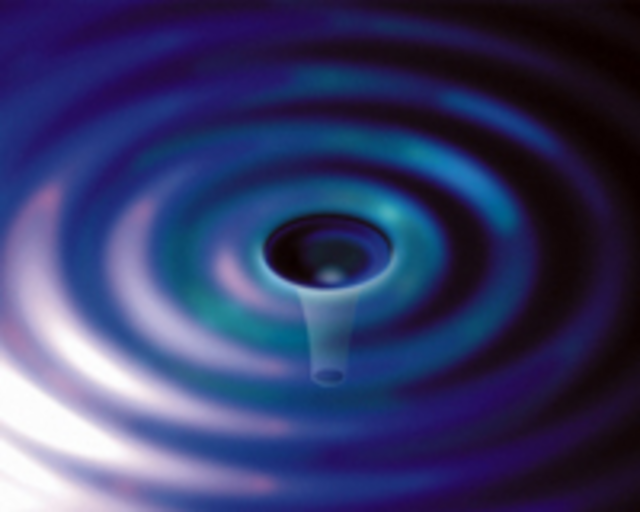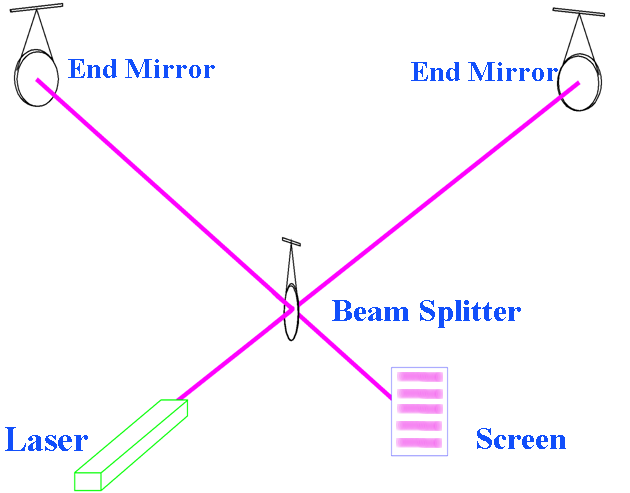
|
The story of Einstein@Home [1] centers on the search for gravitational waves from ultra-dense, rapidly-spinning stars, which we will refer to as pulsars. Pulsars form when normal stars collapse under their own gravity. They contain the Sun's mass in a sphere only 10 km in radius whose area is smaller than an average city, corresponding to more than ten trillion times the density of lead 2.1. They spin as quickly as hundreds of times per second, or several times as fast as a turbo-charged race car engine. The current record-holder [2] (PSR J1748-2446ad) spins at about 43,000 rotations per minute.
According to Einstein's General Theory of Relativity [3,4], a spinning pulsar that is not perfectly round acts as a gravitational-wave generator, stirring up ripples in the fabric of space-time. These ripples, termed gravitational waves, move outward from the star in all directions at the speed of light, eventually reaching the Earth. A handful of international projects seek to measure their passage.

|
Two of these projects, one in the United States (LIGO), and a British and German collaboration (GEO600), are operating several detectors under the auspices of the LIGO Scientific Collaboration (LSC) [6,7,8,9]. The detectors are designed to capture gravitational waves from one of the four principal types of sources: the inspiral of binary black holes or neutron stars, supernova explosions, an overall (stochastic) background, and pulsars. Einstein@Home is designed to search for waves from this last type of source: pulsars. Of course, these projects and Einstein@Home could also discover something new and unexpected!
LIGO and GEO600 use detectors, known as interferometers, that act as huge surveying devices. Rather than marking distances along the Earth's surface, as do conventional surveying tools, the interferometers mark space and time using laser light, which travels along their kilometer-scale perpendicular arms. Within the instruments a semi-transparent mirror splits a laser beam in half. Each half races along one arm of the interferometer, reflects off of an end mirror, and returns to the beam splitter. When the beams recombine at the beam splitter, the electromagnetic fields add coherently, or 'interfere', depending on the relative distances traveled by the beams in their respective arms. This produces either a bright spot or a dark spot at the output of the interferometer which is a very sensitive indicator of any difference in the lengths of the arms. If the polish or alignment of the mirrors is not perfect, then different parts of the beams travel different lengths and a distinctive pattern of light and dark bands (called 'fringes') will appear at the output of the interferometer, as illustrated in Fig. 2.2. Gravitational waves will alternately stretch and shrink the space along the arms by tiny amounts, carrying the suspended mirrors along for the ride, and causing the round-trip light travel time down the arms to oscillate at the frequency of the wave. This will imprint corresponding tiny oscillations in the position of the fringes.

|
Between 2002 and 2005, during breaks in instrument commissioning, several runs of data taking, called "science runs", were completed. The results reported here are from the third science run (S3). At that time (and at the time of this writing, in September 2006) the LIGO instruments are the most sensitive gravitational-wave detectors on the planet, so Einstein@Home is concentrating on analyzing LIGO data.
In November 2005, LIGO began its fifth science run S5, which is the first run at design sensitivity, and is expected to last until August 2007. However, the number of sources and their distances from Earth are uncertain, and in these first few years of operation it is quite possible that the LIGO and GEO instruments may not detect anything. But that will not be the end of the story! Research and development work is underway to upgrade the instruments early in the next decade. After the upgrade, the instruments will be sufficiently sensitive that failure to detect gravitational waves from some of these sources is so unlikely that it could challenge Einstein's prediction of the existence of gravitational waves!
Einstein@Home participants worldwide run computer programs that draw faint gravitational signals out of the background noise, which usually dominates the measured strain. Some of this background noise is caused by vibrations of the atoms in the mirrors and effects from the quantum nature of light. The electronic measurement of the light brightness at the output of the interferometer can also be played through a speaker; random noise creates a nondescript "rumble and hiss" from which the ripples of space-time must be extracted. This file (.au format 126kB) plays a sample of data from the LIGO detector [10]. A similar sound file for the GEO600 detector is also available from this link (.mp3 format 187kB)[11]. Einstein@Home compares the predicted gravitational wave pattern that would be produced by a pulsar to ten-hour-long segments of interferometer data. Episodes of strong agreement between the predicted pattern and the data represent gravitational wave candidates which then face further scrutiny. The computing requirements to identify pulsar candidates are enormous, requiring billions of calculations that must be performed for large numbers of distinct sky positions. The capacity to perform this search on months of data far outstrips the considerable computing resources of the LSC. Einstein@Home functions as a massive worldwide supercomputer to provide this capacity. In late summer 2005 Einstein@Home participants finished analyzing data from the S3 science run (which took place between November 2003 and January 2004). The total number of floating-point operations (that is, additions, subtractions, multiplications and divisions) performed by Einstein@Home in this S3 search was about 10 to the power of 20 (a one followed by 20 zeros). Since then, Einstein@Home has carried out further searches using data from the S4 science run. A new search using S5 data began in June 2006 and will continue well into 2007.
LIGO and GEO greatly appreciate the help of the tens of thousands of Einstein@Home participants who are now running the software. Our hope is to expand the program to a much wider community over the coming years.
To go beyond this brief overview, please read the rest of the pages provided here. These provide a more detailed description of Einstein@Home, the pulsar analysis program, and some of what we have learned so far. And please keep using Einstein@Home!

|
Einstein@Home S3 Analysis Summary |
Last Revised: 2007.03.28 08:59:23 UTC |
Copyright © 2005 Bruce Allen for the LIGO Scientific Collaboration
|
Document version: 1.132 |